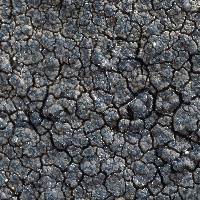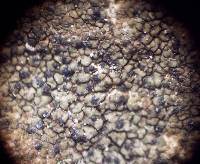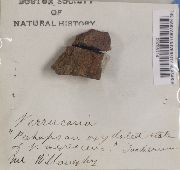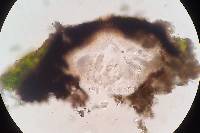
Consortium of Lichen Herbaria
- building a Global Consortium of Bryophytes and Lichens as keystones of cryptobiotic communities -
- Home
- Search
- Images
- Species Checklists
- US States: O-Z >
- US National Parks
- Central America
- South America
- US National Parks
- Southern Subpolar Region
|
|
|
|
Family: Verrucariaceae
[Lichen umbrinus Ach.] |
Nash, T.H., Ryan, B.D., Gries, C., Bungartz, F., (eds.) 2007. Lichen Flora of the Greater Sonoran Desert Region. Vol 3. Thallus: cracked-areolate, determinate, thin to moderately thick (0.1-0.3 mm including the black basal layer), with narrow fissures, bordered by a black prothallus surface: dark olive-green to brown or blackish brown, smooth or somewhat uneven, dull, epruinose anatomy: upper cortex paraplectenchymatous, composed of cells 4-6 µm in diam. with the uppermost ones brown, 10-20 µm thick, overlain by a thin epinecral layer; algal layer: disrupted into small islands resting on the black basal layer, islands 30-120 µm thick; algal cells: 5-10 µm in diam., arranged in ±vertical columns; usually with a well developed black, carbonaceous basal layer that often occupies half or two-thirds of the thallus thickness, without crystals except for the looser, paler lowermost part in contact with the substrate Perithecia: entirely immersed in the thallus or slightly protruding, laterally ±covered by thallus tissue, apex flat to convex; exciple: subglobose, 0.2-0.3 mm wide, dark brown, 15-20 µm thick; involucrellum: contiguous with the exciple, extending down to the lower part of the perithecium and merging with the black basal layer, 30-50 µm thick; periphyses 20-35 µm long, simple asci: clavate, 70-90 x 20-30 µm, 8-spored ascospores: hyaline, simple, ellipsoid, 17-27 x 8-13 µm Pycnidia: unknown Spot tests: all negative Secondary metabolites: none detected. Substrate and ecology: epilithic, predominantly on limestone, walls and mortar, occasionally on siliceous rocks World distribution: western Eurasia, China, North Africa, North America, and Australia Sonoran distribution: rarely found in limestone areas in Arizona, southern California, and Sonora. Notes: Verrucaria nigrescens is characterized by the dark brown, areolated thallus with a rather even surface, involucrellate perithecia sunken into the black basal layer, and medium-sized spores. Many samples filed under that name belong to other species or are not clarified yet. Verrucaria asperula is distinguished by a rough to granular thallus surface. |
|
|
|
Powered by Symbiota





























































































